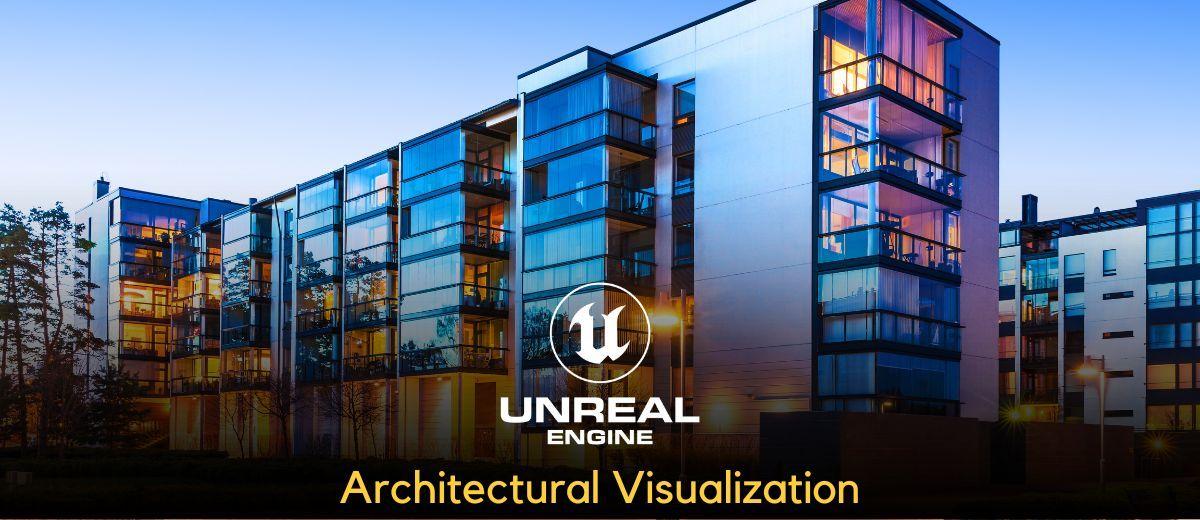- 13th Oct, 2023
- Rohit M.
Unreal Engine and its Impact on Architectural Visualization
3rd Dec, 2023 | Rohit M.
- Emerging Technologies

In the world of architectural visualization, the Unreal Engine stands out as a powerful and versatile tool that has revolutionized the way architects, designers, and developers conceptualize and present their projects.
This article delves into the core features of Unreal Engine, exploring its capabilities and discussing its significance in the field of architecture visualization.
Through a detailed examination of its features and real-world examples, we will highlight how Unreal Engine has become an indispensable asset in the visualization of architectural designs.
What is Unreal Engine?
Unreal Engine, developed by Epic Games, is a cutting-edge real-time 3D creation platform that has gained widespread acclaim for its capabilities across various industries.
Originally designed for game development, Unreal Engine has transcended its initial purpose and evolved into a comprehensive tool for 3D artists, architects, designers, filmmakers, and virtual reality (VR) developers.
The engine's versatility lies in its ability to render high-quality, photorealistic visuals in real-time, providing an immersive experience that goes beyond traditional rendering methods.
Unreal Engine Features that Support Architecture Visualization
Among its many applications, Unreal Engine has become a cornerstone in architecture visualization and interactive design.
Architects and designers now harness its capabilities to create immersive experience, photorealistic experiences that transcend traditional two-dimensional representations.
In this section, we will delve into the key features of Unreal Engine that specifically support architecture visualization, elevating the process of designing and presenting architectural projects.
1. Photorealistic Rendering
Unreal Engine's rendering capabilities stand as a testament to its commitment to visual fidelity. Through advanced techniques such as ray tracing, it achieves unparalleled photorealism, simulating the behaviour of light in the real world.
In architecture visualization, where the accurate depiction of lighting conditions is paramount, this feature becomes a cornerstone for conveying the true essence of a design.
2. High-Quality Materials and Textures
The visual language of architecture relies heavily on materiality. Unreal Engine caters to this need by providing a vast library of high-quality materials and textures.
From the reflective sheen of glass to the nuanced textures of wood and concrete, architects can utilize these resources to enhance the realism of their visualizations, ensuring that designs are communicated with the utmost precision.
3. Dynamic Lighting and Global Illumination
Dynamic lighting is a linchpin in the creation of immersive architectural visualizations. Unreal Engine's dynamic lighting system enables architects to simulate realistic lighting conditions at different times of the day, showcasing how a building or space will appear under various scenarios.
Global illumination further contributes to realism by accurately simulating the indirect bounce of light, creating visually compelling scenes.
4. Real-time Interactivity
Unreal Engine's real-time capabilities introduce a paradigm shift in the way architects engage with their designs. Real-time interactivity means architects can make instant changes to a design during client presentations.
This live interaction fosters a collaborative environment, allowing for immediate feedback and adjustments. Architects and clients can iterate on the design in real-time, ensuring a more refined and client-centric end result.
5. VR and AR Integration
As virtual reality (VR) and augmented reality (AR) technologies become integral to design processes, Unreal Engine seamlessly integrates with these platforms. For architects, this opens up new dimensions of visualization.
Virtual walkthroughs and augmented reality experiences powered by Unreal Engine provide clients with an immersive exploration of a building's design, offering a more intuitive understanding of spatial relationships and scale.
Unreal Engine’s Role in Visualizing Architecture
To understand the impact of Unreal Engine in visualizing architecture, let's explore a few compelling examples:
1. Pureblink uses Unreal Engine to Visualize Real Estate
One striking example of Unreal Engine's impact on real estate visualization comes from Pureblink, a creative agency that leverages Unreal Engine to transform the way real estate is showcased.
In their project, Pureblink seamlessly integrates Unreal Engine into their workflow to create immersive experience and photorealistic visualizations of properties.
Pureblink's application goes beyond static images or traditional walkthroughs. Prospective buyers can experience the property in a truly interactive manner, gaining a sense of scale, spatial flow, and design nuances that traditional methods often fail to convey.
This example highlights the engine's potential to revolutionize the real estate industry by providing a more engaging and informative experience for potential buyers.
2. Revolutionizing Real Estate with XR Digital Twin of Tampa
In this project, Unreal Engine becomes the backbone for a digital twin of the city of Tampa, allowing stakeholders to visualize and interact with proposed changes to the urban landscape.
This example demonstrates the scalability of engine beyond individual properties. By creating a digital twin of an entire city, stakeholders can explore the potential impact of architectural and urban design decisions in a comprehensive and interactive manner.
It's real-time capabilities enable city planners, architects, and policymakers to make informed decisions by immersing themselves in a realistic, virtual representation of the urban environment.

3. Captivating Buyers with Real-Time Technology
Unreal Engine is used to create a virtual showroom for prospective buyers, allowing them to explore and experience homes that are still in the planning or construction phase.
The spotlight showcases how it's real-time rendering and interactivity features enable potential buyers to customize aspects of the home, from materials and colors to furniture placement, in real-time.
This level of personalization creates a strong emotional connection between the buyer and the unbuilt space, fostering a sense of ownership and satisfaction.
It's contribution to the real estate industry extends beyond visual representation to actively shaping the buyer's experience and perception of a property.
These examples underscore the versatility of Unreal Engine in the realm of architecture visualization.
Whether applied to individual properties, city-scale urban planning, or the marketing of unbuilt homes, it's real-time capabilities, photorealistic rendering, and interactive features continue to redefine how architects, developers, and buyers engage with and perceive architectural designs.
As these examples demonstrate, Unreal Engine is not just a tool for rendering images; it is a catalyst for transforming the entire process of visualizing and experiencing architecture.
Conclusion
Unreal Engine stands as a transformative force in architecture visualization, offering a rich array of features that cater specifically to the needs of architects and designers.
From photorealistic rendering to real-time interactivity and seamless VR integration, it transcends traditional limitations, redefining how architectural designs are presented and experienced.
As technology continues to evolve, it remains at the forefront, empowering architects to unleash their creativity and transform abstract ideas into immersive experience, interactive architectural masterpieces.
In a world where visualization is key, it emerges as a catalyst for turning architectural dreams into tangible, captivating realities.
More blogs in "Emerging Technologies"
- 16th Oct, 2023
- Maya R.
Immersive Experience: Transforming Reality through Technology
- 19th Dec, 2023
- Nisha D.
Game Development with Unreal Engine: A Comprehensive Guide
Join our Newsletter
Get insights on the latest trends in technology and industry, delivered straight to your inbox.











